| Part of a series on |
| Islam in India |
|---|
 |
| History |
Architecture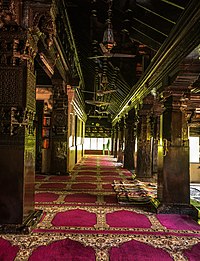 |
| Major figures |
Famous families and ethnicities
|
| Schools of law |
| Contemporary movements |
| Mosques in India |
| Universities |
Influential bodies
|
The Muslim period in the Indian subcontinent or Indo-Muslim period is conventionally said to have started in 712, after the conquest of Sindh and Multan by the Umayyad Caliphate under the military command of Muhammad ibn al-Qasim. It began in the Indian subcontinent in the course of a gradual conquest. The perfunctory rule by the Ghaznavids in Punjab was followed by Ghurids, and Sultan Muhammad of Ghor (r. 1173–1206) is generally credited with laying the foundation of Muslim rule in Northern India.
From the late 12th century onwards, Muslim empires dominated the subcontinent, most notably the Delhi Sultanate and Mughal Empire. Various other Muslim kingdoms ruled most of South Asia from the mid-14th to late 18th centuries, including the Bahmani, Bengal, Gujarat, Malwa, Kashmir, Multan, Mysore, Carnatic and Deccan Sultanates. Though the Muslim dynasties in India were diverse in origin, they were linked together by the Persianate culture and Islam.
The height of Islamic rule was marked during the reign of Mughal Emperor Aurangzeb (r. 1658–1707), during which the Fatawa Alamgiri was compiled, which briefly served as the legal system of Mughal Empire. Additional Islamic policies were re-introduced in South India by Mysore's de facto king Tipu Sultan.
Sharia was used as the primary basis for the legal system in the Delhi Sultanate, most notably during the rule of Firuz Shah Tughlaq and Alauddin Khilji, who repelled the Mongol invasions of India. On the other hand, rulers such as Akbar adopted a secular legal system and enforced religious neutrality. Muslim rule in India saw a major shift in the cultural, linguistic, and religious makeup of the subcontinent. Persian and Arabic vocabulary began to enter local languages, giving way to modern Punjabi, Bengali, and Gujarati, while creating new languages including Hindustani and its dialect, Deccani, used as official languages under Muslim dynasties. This period also saw the birth of Hindustani music, Qawwali. Religions such as Sikhism and Din-e-Ilahi were born out of a fusion of Hindu and Muslim religious traditions as well.
In the 18th century the Islamic influence in India begin to decline following the decline of the Mughal Empire, resulting in former Mughal territory conquered rival powers such as the Maratha Confederacy. However, Islamic rule would still remain under regional Nawabs and Sultans.
Throughout the 18th and 19th centuries, large parts of India were colonized by the East India Company, eventually establishing the British Raj in 1857. Regional Islamic rule would remain under princely states, such as Hyderabad State, Junagadh State, and other minor princely states until the mid of the 20th century.
Today, Bangladesh, Maldives and Pakistan are the Muslim majority nations in the Indian subcontinent while India has the largest Muslim minority population in the world numbering over 204 million.
History
Early Muslim dominions
See also: Muslim conquests in the Indian subcontinent and Umayyad campaigns in IndiaLocal kings who converted to Islam existed in places such as the Western Coastal Plains as early as the 7th century. Islamic rule in India prior to the advent of the Mamluk dynasty (Delhi) included those of Arab Caliphate, Ghaznavids and Ghurids.
Delhi Sultanate
Main article: Delhi Sultanate
The Delhi Sultanate was the first of the two major Islamic empires which was based in mainland India between 1206 and 1526. It emerged after the disintegration of the Ghurid empire in 1206. During the last quarter of the 12th century, Muhammad of Ghor invaded the Indo-Gangetic plain, conquering in succession Ghazni, Multan, Lahore, and Delhi. Qutb-ud-din Aybak, one of his generals proclaimed himself Sultan of Delhi. In Bengal and Bihar, the reign of general Muhammad bin Bakhtiyar Khalji was established. Shamsuddīn Iltutmish (1211–1236), established the Delhi Sultanate on a firm basis, which enabled future sultans to push in every direction. Within the next 100 years, the Delhi Sultanate extended its way east to Bengal and south to the Deccan. The sultanate was in constant flux as five dynasties rose and fell: the Mamluk dynasty (1206–90), Khalji dynasty (1290–1320), Tughlaq dynasty (1320–1413), Sayyid dynasty (1414–51), and Lodi dynasty (1451–1526). Power in Delhi was often gained by violence—nineteen of the thirty-five sultans were assassinated—and was legitimized by reward for tribal loyalty. Factional rivalries and court intrigues were as numerous as they were treacherous; territories controlled by the sultan expanded and shrank depending on his personality and fortunes.
The Delhi sultanate peaked under Muhammad bin Tughlaq in 1335. However, it came under gradual decline afterwards, with kingdoms like the Bengal Sultanate, Madurai Sultanate, Khandesh Sultanate and Bahmani Sultanate all asserting independence. Timur's invasion in 1398 only accelerated the process, and the Gujarat Sultanate and Jaunpur Sultanate broke away. Some of these kingdoms, such as Jaunpur, were again brought back under the Delhi Sultanate's control, although the rest remained independent from central rule until the conquests of the Mughal Empire in the 16th and 17th centuries.
Both the Qur'an and sharia (Islamic law) provided the basis for enforcing Islamic administration over the independent Hindu rulers. According to Angus Maddison, between the years 1000 and 1500, India's GDP, of which the sultanates represented a significant part, grew by nearly 80%, to $60.5 billion; however, this growth was lower than India’s GDP growth during the prior 1,000 years. Additionally, Maddison estimates that India’s population grew by nearly 50% during the same period. The Delhi Sultanate period coincided with a greater use of mechanical technology in the Indian subcontinent. While India previously already had sophisticated agriculture, food crops, textiles, medicine, minerals, and metals, it was not as sophisticated as the Islamic world or China in terms of mechanical technology. Sultan 'Ala ud-Din made an attempt to reassess, systematize, and unify land revenues and urban taxes and to institute a highly centralized system of administration over his realm, but his efforts were abortive. Although agriculture in North India improved as a result of new canal construction and irrigation methods, including what came to be known as the Persian wheel, prolonged political instability and parasitic methods of tax collection brutalized the peasantry. Yet trade and a market economy, encouraged by the free-spending habits of the aristocracy, acquired new impetus both in India and overseas. Experts in metalwork, stonework and textile manufacture responded to the new patronage with enthusiasm. In this period Persian language and many Persian cultural aspects became dominant in the centers of power, as the rulers of the Delhi Sultanate had been thoroughly Persianized since the era of the Ghaznavids.


Mughal Empire
Main article: Mughal EmpireThe Mughal empire was the second & last major Islamic empire to assert dominance over most of the Indian subcontinent between 1526 and 1857. The empire was founded by the Turco-Mongol leader Babur in 1526, when he defeated Ibrahim Lodi, the last ruler of the Delhi Sultanate at the First Battle of Panipat. Babur, Humayun, Akbar, Jahangir, Shah Jahan, and Aurangzeb are known as the six great Mughal Emperors. Apart from the brief interruption of 16 Years by the Afghan Sur Empire between 1540 and 1556, the Mughals continued to rule in one form or other till 1857.
India was producing 24.5% of the world's manufacturing output up until 1750. Mughal economy has been described as a form of proto-industrialization, like that of 18th-century Western Europe prior to the Industrial Revolution.
After the death of Aurangzeb in 1707, the empire declined and reduced subsequently to the region in and around Old Delhi by 1757 to 1760. The decline of the Mughals in the 18th century provided opportunity for the Nawabs of Oudh and Bengal as well as Nizam of Hyderabad to become independent. The empire was formally dissolved by the British Raj after the Indian Rebellion of 1857.
Western and central India
Sultan Alauddin Khalji (r.1296–1316) carried out extensive conquests in the western India. He invaded the kingdoms of Gujarat (raided in 1299 and annexed in 1304), Jaisalmer (1299), Ranthambore (1301), Chittor (1303), Malwa (1305), Siwana (1308), and Jalore (1311). These victories ended several Rajput and other Hindu dynasties, including the Paramaras, the Vaghelas, the Chahamanas of Ranastambhapura and Jalore, the Rawal branch of the Guhilas, and possibly the Yajvapalas; and permanently establishing Muslim rule in the regions of central and western India. After his death, independent Islamic kingdoms emerged there.
Gujarat Sultanate
The Gujarat Sultanate was founded by Sultan Zafar Khan Muzaffar, whose ancestors were Tāṅks from southern Punjab. Earlier, he was the governor of Gujarat appointed by the Tughlaq Sultans of Delhi. However, in the aftermath of the destruction of Delhi by Emir Timur, he declared independence in 1407. The next sultan, his grandson Ahmad Shah I moved the capital to Ahmedabad in 1411. His successor Muhammad Shah II subdued most Rajput chieftains. The prosperity of the sultanate reached its zenith during the rule of Mahmud Begada. He also subdued most Gujarati Rajput chieftains and built a navy off the coast of Diu. In 1509, the Portuguese empire wrested Diu from the Sultanate in the battle of Diu (1509). The Moghul emperor Humayun attacked Gujarat in 1535 and briefly occupied it, during which Bombay, Bassein & Damaon would become a Portuguese colony, thereafter Bahadur Shah was killed by the Portuguese while making a deal in 1537. The end of the sultanate came in 1573, when Akbar annexed Sultanate of Guzerat into his empire. The kingdom was primarily based in the present-day state of Gujarat, India.

Malwa Sultanate
The Malwa Sultanate was another Muslim kingdom in the Malwa region, covering the present day Indian states of Madhya Pradesh and south-eastern Rajasthan from 1392 to 1562. It was founded by Dilawar Khan, who following Timur's invasion and the disintegration of the Delhi Sultanate, in 1401/2, made Malwa an independent realm. In 1561, the Sultanate was conquered by the Mughal empire from its last ruler, Baz Bahadur.
Other Western states
Sindh was ruled by a series of Muslim dynasties including Habbaris, Soomras, Sammas, Arghuns and Tarkhans, after the disintegration of Arab caliphate. Following decline of Mughal empire, Kalhora and Talpur Nawabs ruled Sindh. Kingdom of Mewat was also a prominent Muslim Rajput kingdom in Rajasthan. Gonds of Deogarh was also a Gond/tribal Islamic kingdom located in Nagpur, Maharashtra.
North India
Bengal Sultanate
Main article: Bengal SultanateIn 1339, the Bengal region became independent from the Delhi Sultanate and consisted of numerous Islamic city-states. The Bengal Sultanate was formed in 1352 after Shamsuddin Ilyas Shah, ruler of Satgaon, defeated Alauddin Ali Shah of Lakhnauti and Ikhtiyaruddin Ghazi Shah of Sonargaon; ultimately unifying Bengal into one single independent Sultanate. At its greatest extent, the Bengal Sultanate's realm and protectorates stretched from Jaunpur in the west, Tripura and Arakan in the east, Kamrup and Kamata in the north and Puri in the south.
Although a Sunni Muslim monarchy ruled by Turco-Persians, Bengalis, Habshis and Pashtuns, they still employed many non-Muslims in the administration and promoted a form of religious pluralism. It was known as one of the major trading nations of the medieval world, attracting immigrants and traders from different parts of the world. Bengali ships and merchants traded across the region, including in Malacca, China, Africa, Europe and the Maldives through maritime links and overland trade routes. Contemporary European and Chinese visitors described Bengal as the "richest country to trade with" due to the abundance of goods in Bengal. In 1500, the royal capital of Gaur was the fifth-most populous city in the world with 200,000 residents.
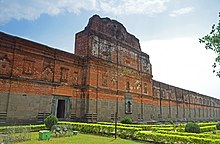
Persian was used as a diplomatic and commercial language. Arabic was the liturgical language of the clergy, and the Bengali language became a court language. The patronage of the sultans raised Bengali from the language of the masses. Sultan Ghiyathuddin Azam Shah sponsored the construction of madrasas in Makkah and Madinah. The schools became known as the Ghiyasia Banjalia Madrasas. Taqi al-Din al-Fasi, a contemporary Arab scholar, was a teacher at the madrasa in Makkah. The madrasa in Madinah was built at a place called Husn al-Atiq near the Prophet's Mosque. Several other Bengali Sultans also sponsored madrasas in the Hejaz.
The Karrani dynasty was the last ruling dynasty of the sultanate. The Mughals became determined to bring an end to the independent kingdom. Mughal rule formally began with the Battle of Rajmahal in 1576, when the last Sultan Daud Khan Karrani was defeated by the forces of Emperor Akbar, and the establishment of the Bengal Subah. The eastern deltaic Bhati region remained outside of Mughal control until being absorbed in the early 17th century. The delta was controlled by a confederation of aristocrats of the Sultanate, who became known as the Baro-Bhuiyans. The Mughal government eventually suppressed the remnants of the Sultanate and brought all of Bengal under full Mughal control.
Jaunpur Sultanate
The Jaunpur Sultanate was founded in 1394 by Khwajah-i-Jahan Malik Sarwar, a eunuch slave and former wazir of Sultan Nasiruddin Muhammad Shah IV Tughluq, amidst the disintegration of the Delhi Sultanate's Tughlaq dynasty. It was centred in Jaunpur, and the Sultanate extended authority over Awadh and a large part of the Ganges-Yamuna Doab between 1394 and 1479. It reached its greatest height under the rule of Sultan Ibrahim Shah, who also vastly contributed to the development of Islamic education in the Sultanate. In 1479, Sultan Hussain Khan was defeated by the forces of Bahlul Lodi, Sultan of the Lodi dynasty of the Delhi Sultanate, which abruptly brought an end to independent Jaunpur and its reabsorption into the Delhi Sultanate.
Nawabs of Bengal
Nawab was a title given by the Mughals to the governors of different provinces. During disintegration of the empire in the 18th century, many Nawabs became de facto independent.
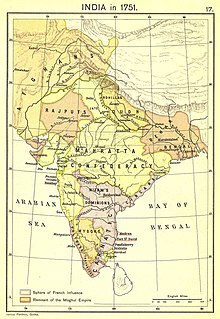
In the early 18th-century, the Nawabs of Bengal and Murshidabad were the de facto independent ruler of the three regions of Bengal, Bihar, and Orissa which constitute the modern-day sovereign country of Bangladesh and the Indian states of West Bengal, Bihar and Orissa. The Nawabs of Bengal oversaw a period of proto-industrialization. The region was a major production center for cotton muslin cloth, silk cloth, shipbuilding, gunpowder, saltpetre, and metalworks. The British company eventually challenged the authority of the Nawabs. In the aftermath of the siege of Calcutta in 1756, in which the Nawab's forces overran the main British base, the East India Company dispatched a fleet led by Robert Clive who defeated the last independent Nawab Siraj-ud-Daulah at the Battle of Plassey in 1757. Mir Jafar was installed as the puppet Nawab. His successor Mir Qasim attempted in vain to dislodge the British. The defeat of Nawab Mir Qasim of Bengal, Nawab Shuja-ud-Daula of Oudh, and Mughal Emperor Shah Alam II at the Battle of Buxar in 1764 paved the way for British expansion across India.
Nawabs of Awadh
Nawab of Awadh ruled major parts of present-day Uttar Pradesh. The Nawabs of Awadh, along with many other Nawabs, were regarded as members of the nobility of the greater Mughal Empire. They joined Ahmad Shah Durrani during the Third Battle of Panipat (1761) and restored Shah Alam II (r. 1760–1788 and 1788–1806) to the imperial throne. The Nawab of Awadh also fought the Battle of Buxar (1764) preserving the interests of the Moghul. Oudh State eventually declared itself independent from the rule of the "Great Moghul" in 1818.
Oudh joined other Indian states in an upheaval against British rule in 1858 during one of the last series of actions in the Indian rebellion of 1857. In the course of this uprising detachments of the British Indian Army from the Bombay Presidency overcame the disunited collection of Indian states in a single rapid campaign. Determined rebels continued to wage sporadic guerrilla clashes until the spring of 1859. This rebellion is also historically known as the Oudh campaign.
Other Northern states
In northern India, the Multan-based Langah Sultanate and the Kashmir Sultanate were established during the 14th century. Nobles in the court of the Delhi Sultanate founded other Islamic dynasties elsewhere in India including Khandesh Sultanate. The Kingdom of Rohilkhand was also a major power in northern India in the 18th century.
South India
Till the early 14th century, south India was ruled by Hindu dynasties. During the reign of Sultan Alauddin Khalji (r.1296–1316), his slave-general Malik Kafur led multiple campaigns to the south of the Vindhyas, obtaining a considerable amount of wealth from Devagiri (1308), Warangal (1310) and Dwarasamudra (1311). These victories forced the Yadava king Ramachandra, the Kakatiya king Prataparudra, and the Hoysala king Ballala III to become Alauddin's tributaries. In 1321, Muhammad bin Tughluq was sent by his father to the Deccan Plateau to fight a military campaign against the Kakatiya dynasty. In 1323, the future sultan successfully laid siege upon the Kakatiya capital in Warangal. This victory over King Prataparudra ended the Kakatiya dynasty. Although the control of Delhi sultanate was weakened after 1335 in the south, its successor Muslim states continued to rule Deccan plateau for next several centuries.
Bahmani Sultanate
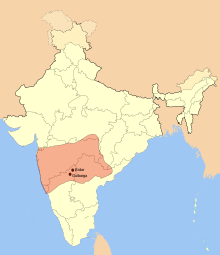
The Muhammad bin Tughlaq's failure to hold securely the Deccan and South India resulted in the rise of competing for Southern dynasties: the Muslim Bahmani Sultanate (1347–1518) and the Hindu Vijayanagara Empire (1336–1646). Zafar Khan, a former provincial governor under the Tughluqs, revolted against Delhi Sultans and proclaimed himself sultan, taking the title Ala-ud-Din Bahman Shah in 1347. It was the first Muslim empire located in the Deccan region. Bahmani empire was known for its perpetual wars with its rival Vijayanagara, which would outlast the Sultanate. The Bahmani Sultans were patrons of the Persian language, culture and literature, and some members of the dynasty became well-versed in that language and composed its literature in that language. The Bahmani Sultanate adopted the patterns established by the Delhi overlords in tax collection and administration, but its downfall was caused in large measure by the competition and hatred between Deccani (domiciled Muslim immigrants and local converts) and paradesi (foreigners or officials in temporary service). The Bahmani Sultanate initiated a process of cultural synthesis visible in Hyderabad where cultural flowering is still expressed in vigorous schools of Deccani architecture and painting. The later rulers are buried in an elaborate tomb complex, known as the Bahmani Tombs. The exterior of one of the tombs is decorated with coloured tiles. Arabic, Persian and Urdu inscriptions are inscribed inside the tombs.
Deccan sultanates
Main articles: Bahmani Sultanate and Deccan sultanatesThe Bahmani Sultanate lasted for almost two centuries, until it fragmented into five smaller states, known as the Deccan sultanates (Bijapur, Golconda, Ahmednagar, Berar, and Bidar) in 1527. Although the five sultanates were all ruled by Muslims, their founders were of diverse, and often originally non-Muslim origins: the Ahmadnagar Sultanate was of Hindu-Brahmin origins; the Berar sultanate by a Kannadiga Hindu convert; the Bidar Sultanate was founded by a Georgian slave; the Bijapur Sultanate was founded by a Georgian slave purchased by Mahmud Gawan and the Golconda Sultanate was of Turkmen origin.

The rulers of the Deccan sultanates made a number of cultural contributions in the fields of literature, art, architecture, and music. An important contribution was the development of the Dakhani language, which, having started development under the Bahamani rulers, developed into an independent spoken and literary language during this period by continuously borrowing from Arabic-Persian, Marathi, Kannada, and Telugu. Dakhani later became known as Dakhani Urdu to distinguish it from North Indian Urdu. Deccani miniature painting—which flourished in the courts of Ahmadnagar, Bijapur, and Golconda—is another major cultural contribution of the Deccan sultanates.
When the rulers of the five Deccan sultanates combined their forces and attacked the Vijayanagara empire in 1565, the empire crumbled at the Battle of Talikot.
Nizams of Hyderabad
Nizam, a shortened version of Nizam-ul-Mulk, meaning Administrator of the Realm, was the title of the native sovereigns of Hyderabad state, India, since 1719, belonging to the Asaf Jahi dynasty. The dynasty was founded by Mir Qamar-ud-Din Siddiqi, a viceroy of the Deccan under the Mughal emperors from 1713 to 1721 who intermittently ruled under the title "Asaf Jah" in 1924. After Aurangzeb's death in 1707, the Mughal Empire crumbled, and the viceroy in Hyderabad, the young Asaf Jah, declared..himself independent.
The dynasty ruled for 7 generations, with the last Nizam – Mir Osman Ali Khan showing an enormous contributions on the field of education, construction of major public buildings across the kingdom, setting up of Nizam's Guaranteed State Railway(NSGR), donations to Universities, temples and donating 14,000 acres (5,700 ha) of land from his personal estate to Vinobha Bhave's Bhoodan movement.
Mysore Kingdom
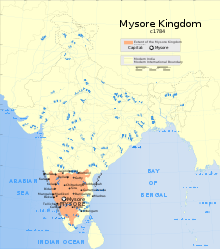
Hyder Ali and Tipu Sultan held power and were de facto rulers of the proto-industrialised Mysore Sultanate during the latter part of the 18th century. They made alliances with France and fought the Anglo-Mysore Wars predominantly against the British.
Carnatic Sultanate
The Carnatic Sultanate was a kingdom in South India between about 1690 and 1855, and was under the legal purview of the Nizam of Hyderabad, until their demise. The Nawabs of Carnatic eventually ceded tax rights to the British in 1801 following Carnatic wars, and the kingdom was abolished.
Other Southern states
Other southern states include the Arakkal Kingdom (of modern-day Kerala) who were a subordinate of their masters the Kolathiris and the short-lived Madurai Sultanate which was centered in and around Madurai and existed for barely 40 years.
See also
Portals:Literature
- Majumdar, Ramesh Chandra; Pusalker, A. D.; Majumdar, A. K., eds. (1960). The History and Culture of the Indian People. Vol. VI: The Delhi Sultanate. Bombay: Bharatiya Vidya Bhavan.
- Majumdar, Ramesh Chandra; Pusalker, A. D.; Majumdar, A. K., eds. (1973). The History and Culture of the Indian People. Vol. VII: The Mughal Empire. Bombay: Bharatiya Vidya Bhavan.
- Elliot, Sir H. M., Edited by Dowson, John. The History of India, as Told by Its Own Historians. The Muhammadan Period; published by London Trubner Company 1867–1877. (Online Copy: The History of India, as Told by Its Own Historians. The Muhammadan Period; by Sir H. M. Elliot; Edited by John Dowson; London Trubner Company 1867–1877 – This online Copy has been posted by: The Packard Humanities Institute; Persian Texts in Translation; Also find other historical books: Author List and Title List)
References
- Goetz, Hermann (1934). "The Genesis of Indo-Muslim Civilization: Some Archaeological Notes". Ars Islamica. 1 (1): 46–50. ISSN 1939-6406.
- Tripathi, R. P. (1956). Some Aspects of Muslim Administration. Allahabad: Central Book Depot. p. 24.
- Noah), Abu Noah Ibrahim Ibn Mika'eel Jason Galvan (Abu; Galvan, Jason (30 September 2008). Art Thou That Prophet?. Lulu.com. ISBN 978-0-557-00033-3. Archived from the original on 2 May 2021. Retrieved 1 December 2021.
- Syed, Muzaffar Husain; Akhtar, Syed Saud; Usmani, B. D. (14 September 2011). Concise History of Islam. Vij Books India Pvt Ltd. ISBN 978-93-82573-47-0. Archived from the original on 26 April 2021. Retrieved 1 December 2021.
- Stanley Lane-Poole (1 January 1991). Aurangzeb And The Decay Of The Mughal Empire. Atlantic Publishers & Distributors (P) Limited. ISBN 978-81-7156-017-2.
- Chapra, Muhammad Umer (2014). Morality and Justice in Islamic Economics and Finance. Edward Elgar Publishing. pp. 62–63. ISBN 9781783475728.
- B. N. Pande (1996). Aurangzeb and Tipu Sultan: Evaluation of Their Religious Policies. University of Michigan. ISBN 9788185220383.
- Madan, T. N. (5 May 2011). Sociological Traditions: Methods and Perspectives in the Sociology of India. SAGE Publications India. ISBN 978-81-321-0769-9. Archived from the original on 5 May 2021. Retrieved 1 December 2021.
- Avari, Burjor (2013). Islamic Civilization in South Asia: A History of Muslim Power and Presence in the Indian Subcontinent. Routledge. ISBN 978-0-415-58061-8. Archived from the original on 11 April 2023. Retrieved 1 December 2021.
- Khan, Abdul Jamil (2006). Urdu/Hindi: An Artificial Divide: African Heritage, Mesopotamian Roots, Indian Culture & British Colonialism. Algora Publishing. ISBN 978-0-87586-438-9. Archived from the original on 21 November 2021. Retrieved 1 December 2021.
- Goldberg, K. Meira; Bennahum, Ninotchka Devorah; Hayes, Michelle Heffner (6 October 2015). Flamenco on the Global Stage: Historical, Critical and Theoretical Perspectives. McFarland. ISBN 978-0-7864-9470-5. Archived from the original on 4 May 2021. Retrieved 1 December 2021.
- Lavezzoli, Peter (24 April 2006). The Dawn of Indian Music in the West. A&C Black. ISBN 978-0-8264-1815-9. Archived from the original on 2 May 2021. Retrieved 1 December 2021.
- Oberst, Robert (27 April 2018). Government and Politics in South Asia, Student Economy Edition. Routledge. ISBN 978-0-429-97340-6.
- Gat, Azar (2013). Nations: The Long History and Deep Roots of Political Ethnicity and Nationalism. Cambridge University Press. p. 126. ISBN 9781107007857.
- Richard M. Eaton (2019). India in the Persianate Age: 1000–1765. University of California Press. p. 117. ISBN 978-0520325128.
The career of Khizr Khan, a Punjabi chieftain belonging to the Khokar clan...
- André Wink (2020). The Making of the Indo-Islamic World:C.700-1800 CE. Cambridge University Press. p. 83. ISBN 978-1-108-41774-7. Archived from the original on 5 April 2023. Retrieved 19 March 2023.
- Madison, Angus (6 December 2007). Contours of the world economy 1–2030 AD: essays in macro-economic history. Oxford University Press. p. 379. ISBN 978-0-19-922720-4.
- Madison 2007, p. 376.
- Pacey, Arnold (1991) . Technology in World Civilization: A Thousand-Year History. The MIT Press. p. 10.
- Bennett, Clinton; Ramsey, Charles M. (March 2012). South Asian Sufis: Devotion, Deviation, and Destiny. A&C Black. ISBN 9781441151278. Archived from the original on 14 November 2020. Retrieved 2 January 2015.
- Jeffrey G. Williamson & David Clingingsmith, India's Deindustrialization in the 18th and 19th Centuries Archived 29 March 2017 at the Wayback Machine, Global Economic History Network, London School of Economics
- Wink, André (2003). Indo-Islamic society: 14th – 15th centuries. BRILL. p. 143. ISBN 978-90-04-13561-1.
Similarly, Zaffar Khan Muzaffar, the first independent ruler of Gujarat, was not a foreign Muslim but a Khatri convert, of a low subdivision called the Tank, originally from southern Punjab.
- Haig, T.W. & Islam, Riazul (1991). "Mālwā". In Bosworth, C. E.; van Donzel, E. & Pellat, Ch. (eds.). The Encyclopaedia of Islam, Second Edition. Volume VI: Mahk–Mid. Leiden: E. J. Brill. ISBN 978-90-04-08112-3.
- "Gaur and Pandua Architecture". Sahapedia. Archived from the original on 13 November 2020. Retrieved 12 February 2020.
- "He founded the Bengali Husayn Shahi dynasty, which ruled from 1493 to 1538, and was known to be tolerant to Hindus, employing many on them in his service and promoting a form of religious pluralism" David Lewis (31 October 2011). Bangladesh: Politics, Economy and Civil Society. Cambridge University Press. pp. 44–45. ISBN 978-1-139-50257-3.
- Richard M. Eaton (31 July 1996). The Rise of Islam and the Bengal Frontier, 1204–1760. University of California Press. pp. 64–. ISBN 978-0-520-20507-9. Archived from the original on 22 October 2023. Retrieved 12 February 2020.
- Bar chart race: the most populous cities through time, archived from the original on 12 December 2021, retrieved 22 December 2019
- Kapadia, Aparna (30 March 2019). "Gujarat's medieval cities were once the biggest in the world – as a viral video reminds us". Scroll.in. Archived from the original on 8 November 2020. Retrieved 22 December 2019.
- "Evolution of Bangla". The Daily Star. 21 February 2019. Archived from the original on 11 September 2020. Retrieved 31 December 2019.
- Muhammad Mojlum Khan (2013). The Muslim Heritage of Bengal: The Lives, Thoughts and Achievements of Great Muslim Scholars, Writers and Reformers of Bangladesh and West Bengal. Kube Publishing Ltd. p. 37. ISBN 978-1-84774-059-5.
- Richard M. Eaton (31 July 1996). The Rise of Islam and the Bengal Frontier, 1204–1760. University of California Press. p. 47. ISBN 978-0-520-20507-9. Archived from the original on 6 January 2017.
- Abdul Karim. "Ghiyasia Madrasa". Banglapedia: National Encyclopedia of Bangladesh. Asiatic Society of Bangladesh. Archived from the original on 8 August 2016. Retrieved 12 February 2020.
- "Jalaluddin Muhammad Shah". Banglapedia. Archived from the original on 7 July 2015.
- "Bengal | region, Asia". Encyclopædia Britannica. 2 December 2023. Archived from the original on 19 October 2021. Retrieved 26 January 2023.
- "Odisha – History". Encyclopædia Britannica. 3 December 2023. Archived from the original on 28 September 2021. Retrieved 26 January 2023.
- "As children, we wanted revenge on the British". The Times of India. 30 September 2016. Archived from the original on 9 May 2019. Retrieved 13 April 2019.
- Michael Edwardes, Battles of the Indian Mutiny, Pan, 1963, ISBN 0-330-02524-4
- Richard M. Eaton (2005). A Social History of the Deccan, 1300–1761: Eight Indian Lives · Part 1, Volume 8. Cambridge University Press. p. 75. ISBN 978-0-521-25484-7. Archived from the original on 11 April 2023. Retrieved 19 March 2023.
- "The Five Kingdoms of the Bahmani Sultanate". orbat.com. Archived from the original on 23 February 2007. Retrieved 5 January 2007.
- George C. Kohn (2006). Dictionary of Wars. Infobase Publishing. ISBN 9781438129167.
- ^ Yazdani, Ghulam (1947). Bidar, Its History and Monuments. London: Oxford University Press. pp. 114–142.
- Sara Mondini (2016). "The Use of Quranic Inscriptions in the Bahmani Royal Mausoleums The Case of Three Tombstones from Ashtur". Eurasiatica. 4. doi:10.14277/6969-085-3/EUR-4-12.
- "Deccani painting". Encyclopedia Britannica. Archived from the original on 27 January 2019. Retrieved 27 January 2019.
- "Nizam Hyderabad Mir Osman Ali Khan was a perfect secular ruler". The Siasat Daily – Archive. 13 August 2015. Archived from the original on 17 September 2018. Retrieved 8 September 2022.
- Sunil, Mungara (4 September 2016). "Much of Bhoodan land found to be under encroachment in city". The Times of India. TNN / Updated. Archived from the original on 13 October 2022. Retrieved 5 September 2022.
- Kenneth Pletcher, ed. (1 April 2010). The History of India. Britannica Educational Publishing. p. 219. ISBN 9781615302017.
- Ramaswami, N. S. (1 January 1984). Political History of Carnatic Under the Nawabs. Abhinav Publications. p. 104. ISBN 9780836412628.
 This article incorporates text from this source, which is in the public domain. Country Studies. Federal Research Division. – India, Pakistan
This article incorporates text from this source, which is in the public domain. Country Studies. Federal Research Division. – India, Pakistan